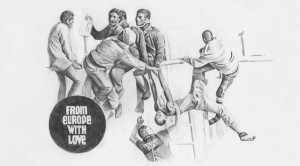Luxembourg Pavilion at the 56th Venice Biennale.
Filip Markiewicz
Paradiso Lussemburgo
9 May–22 November 2015
Hours: Tuesday–Sunday, 10am–6pm
Pavilion of Grand Duchy of Luxembourg
Ca’ del Duca
Corte del Duca Sforza
San Marco 3052
Venice
Curator: Paul Ardenne
Born in 1980 to Polish parents in Luxembourg, Filip Markiewicz graduated in Visual Arts from the University of Strasbourg (France). He lives and works in Hamburg (Germany). At the Ca’ del Duca, the Luxembourg Pavilion at the 56th International Art Exhibition – la Biennale di Venezia, he presents Paradiso Lussemburgo: a documentary, critical and documentary “portrait” of the Grand Duchy.
As someone with a sharp eye for the vicissitudes of contemporary life, the rise of political extremes in the West and the progress of ethnic divides—issues his work tackles in a simultaneously informed, unbridled and subtle manner—Markiewicz assumes the role of the postmodern, politically conscious artist, a relentless whistle-blower who asks questions rather than claiming to have the answers. His intriguing work unfurls through multiple visual and reflexive sequences, combining genres, styles and mediums (with a preference for drawing and film) to reveal the anomalies, distortions, subterfuges and violence of reality in the political and moral realm.
Journey to the End of an Identity
With Paradiso Lussemburgo, Filip Markiewicz presents a mental image of Luxembourg combined with a reflection on contemporary identity. Through its title, Paradiso Lussemburgo evokes both the Paradiseof Dante, the movie Cinema Paradiso by Giuseppe Tornatore and tax havens. As the artist points out: “What interests me is, on the one hand, the mythological aspect, close to the fable, and on the other hand, popular appearance. The various waves of immigration recorded since the beginning of the twentieth century in Luxembourg have led to the country being seen as a sort of paradise for integration. Again, there is a strong allusion to the image of Luxembourg given by some foreign media, the tax haven, a theme addressed here head-on but also with a certain irony.”
The work takes the form of a vast “total” theatre that fully occupies six rooms of the pavilion. At once museum, creative laboratory, a place of cultural entertainment combining dance, performance, DJing, reading, architecture and music, Paradiso Lussemburgo presents Luxembourg, in the European and global context, as a national sample in which the various nationalities and cultures constituting the same identity are combined. It is a journey to the outer limits of a plural and complex identity, in a way that is both critical, political and fantastical.
All the World’s Futures
By associating himself with Filip Markiewicz, Paul Ardenne is going back to his intellectual roots as a historian geographer and specialist in modern and contemporary history: “My hope, as curator of the exhibition, is that the spectators visit the pavilion without prejudice or a priori. Filip Markiewicz’s work is a visual allegory, a metaphor, a ‘vision.’ It is a proposition, not an expression of truth. It is therefore not about agreeing but gleaning an impression, sensations. This pavilion should not just be visited. It should also be experienced, felt, tasted. You can also dance in it, drink beer in it, while awaiting All the World’s Futures.”
Image: Filip Markiewicz, From Europe with Love. Courtesy Luxembourg Pavilion.


